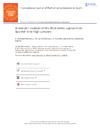Please use this identifier to cite or link to this item:
https://accedacris.ulpgc.es/jspui/handle/10553/106692
| DC Field | Value | Language |
|---|---|---|
| dc.contributor.author | Mateos-Padorno, C. | en_US |
| dc.contributor.author | García Manso, Juan Manuel | en_US |
| dc.contributor.author | Fuentes-García, J.P. | en_US |
| dc.contributor.author | Martínez-Patiño, Mª.J. | en_US |
| dc.date.accessioned | 2021-04-12T07:27:08Z | - |
| dc.date.available | 2021-04-12T07:27:08Z | - |
| dc.date.issued | 2021 | en_US |
| dc.identifier.issn | 2474-8668 | en_US |
| dc.identifier.uri | https://accedacris.ulpgc.es/handle/10553/106692 | - |
| dc.description.abstract | In high jumping, the horizontal velocity which jumpers aim to reach by the end of the run-up must be the maximum that they can control, enabling them to clear the greatest height possible. Furthermore, jumpers should reach the point of take-off with the lowest possible centre of mass (CM) to increase the thrust during take-off and thus produce a greater vertical velocity of the CM at the end of this phase. The aim of this study was to identify gender-related differences in the kinematic parameters of the sprint. The sample comprised 14 high jumpers (n = 8 males and n = 6 females) who were analysed during an official competition and recorded with four high speed panning cameras (sampling frequency: 50 fps). The results showed gender-related differences in the maximum height attained by the centre of mass during the flight phase (p = 0.004; Effect Size = 0.93) and in flight effectiveness (p ≤ 0.001; ES = 5.53), but not in jump effectiveness. Gender-related differences were not detected between the trajectory followed by the CM in the final supports of the run-up and the curve radius or in the direction of the final supports either. In conclusion, there are no significant gender differences in the run-up. | en_US |
| dc.language | eng | en_US |
| dc.relation.ispartof | International Journal Of Performance Analysis In Sport | en_US |
| dc.source | International Journal Of Performance Analysis In Sport [2474-8668], v. 21(3), p. 421-434, (Abril 2021) | en_US |
| dc.subject | 5802 Organización y planificación de la educación | en_US |
| dc.subject.other | Track and field | en_US |
| dc.subject.other | High jump | en_US |
| dc.subject.other | Run-up | en_US |
| dc.subject.other | Kinematical analysis | en_US |
| dc.subject.other | Gender difference | en_US |
| dc.title | Kinematic analysis of the final stride approach in Spanish elite high jumpers | en_US |
| dc.type | info:eu-repo/semantics/article | en_US |
| dc.type | Article | en_US |
| dc.identifier.doi | 10.1080/24748668.2021.1908040 | en_US |
| dc.investigacion | Ciencias Sociales y Jurídicas | en_US |
| dc.type2 | Artículo | en_US |
| dc.utils.revision | Sí | en_US |
| dc.date.coverdate | Abril, 2021 | en_US |
| dc.identifier.ulpgc | Sí | en_US |
| dc.contributor.buulpgc | BU-FIS | en_US |
| dc.description.sjr | 0,708 | |
| dc.description.jcr | 2,488 | |
| dc.description.sjrq | Q2 | |
| dc.description.jcrq | Q3 | |
| dc.description.scie | SCIE | |
| dc.description.miaricds | 8,8 | |
| item.grantfulltext | open | - |
| item.fulltext | Con texto completo | - |
| crisitem.author.dept | GIR Economía de las Infraestructuras, el Transporte y el Turismo | - |
| crisitem.author.dept | Departamento de Educación Física | - |
| crisitem.author.dept | GIR Praxiología motriz, entrenamiento deportivo, didáctica de las actividades físicas y salud | - |
| crisitem.author.orcid | 0000-0003-2406-6031 | - |
| crisitem.author.orcid | 0000-0002-4360-3384 | - |
| crisitem.author.parentorg | Departamento de Análisis Económico Aplicado | - |
| crisitem.author.parentorg | Departamento de Educación Física | - |
| crisitem.author.fullName | Mateos Padorno, Covadonga | - |
| crisitem.author.fullName | García Manso, Juan Manuel | - |
| Appears in Collections: | Artículos | |
Page view(s)
161
checked on Dec 28, 2024
Download(s)
669
checked on Dec 28, 2024
Google ScholarTM
Check
Altmetric
Share
Export metadata
Items in accedaCRIS are protected by copyright, with all rights reserved, unless otherwise indicated.
